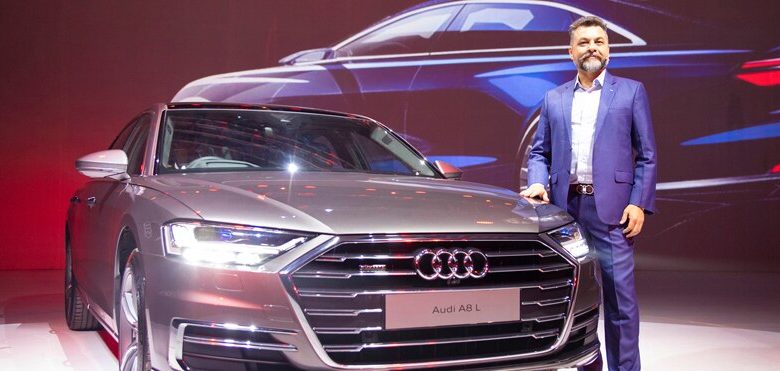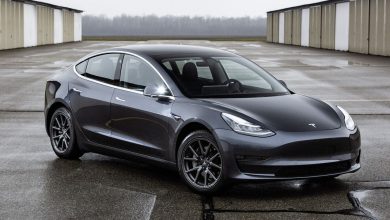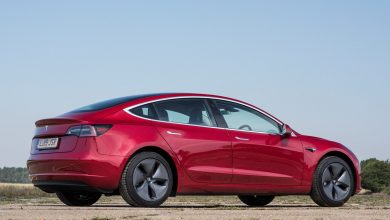Audi 4th Generation A8L launched in India – “Opulence redefined”

The German luxury car manufacturer, Audi, released the 4th-gen of its flagship sedan on February 3rd, 2020 at New Delhi. The model is Audi A8 L 55 TFSI.
Now, before we get into the specifications of the model, here’s what Mr. Balbir Singh Dhillon, Head of Audi India, said at the launch, “The new A8 L marks the dawn of a new design era for brand Audi. The car is sophisticated, technology and feature-rich. We have fundamentally re-engineered the Audi A8 L in its fourth generation – it now boasts larger dimensions and is heavily customizable. We want customers to customize their car keeping in mind their likes and requirements and are confident that the new Audi A8 L will witness the same success that its predecessors have enjoyed in the country.”
The fourth generation of Audi A8 boasts of a 3.0litre Petrol engine that can reach 0-100 in just 5.7 seconds. Coming to the power of the V6 3.0 TFSI motor, it is capable of generating 340hp along with 500Nm of torque. Considering the torque, it can be easily determined that the weight of the car isn’t too light. Well, now the Audi fans can cut through the wind without any instability! Not only is the speed range impressive, but the engine also allows travelling up to 40 seconds with zero emissions. This is due to the fact that the model comes equipped with 48V mild-hybrid technology. Finally, due to this same technology, fuel consumption is brought down by 0.7 litres for every 100 kilometres. The gear system is an eight-stage Tiptronic transmission that comes with a lock-up clutch. The model comes with the standard Quattro permanent all-wheel-drive system paired with self-locking differential.
Coming to the chassis of the new model, it’ll be optionally available in dynamic all-wheel steering. This will redefine the limits of steering angle possibilities since it allows the rear and front axles to be set independent of each other. The stability provided when driving is a combination of delay-free response and superior steering behaviour. The Audi Drive Select System allows an individual mode which can be used to customise the driving experience. Finally, revolutionary technologies and various control systems make the new generation model much more sporty, comfortable, and safe.
Next, let’s have a deeper look at the exterior of the model. The fourth-generation model is 1.95 metres wide, 5.3 metres long, and 1.49 metres tall. The frame of the model follows the Audi Space Frame Principle. Comparing the strength of the model to its predecessor, due to the existence of 58% aluminium parts, the strength has increased significantly. The body has been created with a mixture of four different materials which provide a new-level multi-material design. The cabin of the model is made with hot-formed steel components and has an ultra-high-strength firm rear panel which is made from carbon fibre polymer. Not only that, the headlamps of the model are equipped with top-class HD matrix LED headlights along with the Audi Laser Lights. The rear lamps are equipped with OLED technology. Even though the existence of the magnesium strut-tower bar helps with the light-weight structure concept, the model has super hardness with a foundation for riding comfort, precise handling, and acoustic tranquillity.
Considering the model boasts of comfort, we have to take a look at the interior of the car. It comes with a 10.1-inch display system which blends perfectly with the high-gloss black surroundings and black panel when switched off. There’s a second touch screen on the centre tunnel console which can be used to operate climate control, handwriting recognition, and other features. A voice recognition system in the model allows the driver to activate various functions through voice control using spoken commands. Not only this, the dialogue manager will provide corrections, suggestions, and choices when deemed necessary. The user experience is further enhanced by allowing the driver to receive Acoustic and Haptic feedback on the activation of a function on one of the two displays. The steering wheel comes with multifunctional options and a head-up display which makes the operating concept complete. Last but not the least, a total of five touchscreens are available in the new generation A8 which suits all the functional and entertainment requirements of the user.
For the motorheads who need to blast it off while cruising the streets, here’s what the model comes with. It has B&O 3D Surround Sound System with a standard front 3D Spatial Sound. As an option, 23 speaker 1920 W Bang and Olufsen Advanced Sound System is available. For the first time, Audi has included 3D sound with height information for the rear seats. It’s like hearing the music unfold like you would in a concert! Finally, there’s the MMI Navigation System, Audi Phone box at the front, and the optional rear-seat telephony.
A model that comes with such specifications will not let us down when it’s about safety. The model has Audi Pre-Sense Basic, a total of 8 airbags which can be upgraded to 10, and finally, there are two more central airbags for extra protection. In case there is a rear-ended collision the Active Head Restraints protect the neck from whiplash. Lastly, there are Surround Cameras with a superior 3D view which allow the driver to negotiate the car out of tight spaces. It even allows the display to be zoomed for the perfect view of a tight corner.
Mr. Dhillon, at the launch, said “We are pushing the edge on modern luxury with a great-looking cabin and an ultra-luxurious rear with features that are irresistible for flagship followers. The A8 L is the epitome of luxury and forms an extremely important part of our product portfolio for 2020 that focuses on the push for C & D segment cars. The A8 L is our third completely new BS-VI compliant model launch after the All-New Audi A6 and Audi Q8.”
The pricing of the model starts with INR 1.56 crores and increases with added features.




